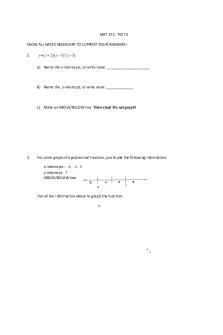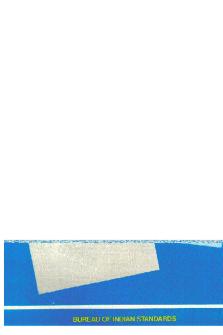Test 3 Sp 21 - adfdf PDF

| Title | Test 3 Sp 21 - adfdf |
|---|---|
| Author | Jordan Briana |
| Course | Precalculus Algebra |
| Institution | Central Piedmont Community College |
| Pages | 9 |
| File Size | 335.2 KB |
| File Type | |
| Total Downloads | 70 |
| Total Views | 162 |
Summary
adfdf...
Description
MAT 171: TEST 3 SHOW ALL WORK NECESSARY TO SUPPORT YOUR ANSWERS! 1.
y = ( x + 2 )( x −1)
2
( x − 3)
a) Name the x-intercepts, or write none. _____________________
b) Name the y-intercept, or write none. _____________
c) Make an ABOVE/BELOW line. Then stop! Do not graph!
2.
For some graph of a polynomial function, you found the following information: x-intercepts: −4, − 1, 5 y-intercept: 7 ABOVE/BELOW line:
Use all the information above to graph the function. y
x
3.
y=
2x − 6 x+1
a) Find the equation of the horizontal asymptote, or write none. ___________
b) Find the equation of each vertical asymptote, or write none. ___________________
c) Find the y-intercept, or write none. ______________
d) Find each x-intercept, or write none. _____________
e) Make an ABOVE/BELOW line. Remember: Put your numbers from parts (b) and (d) on the number line.
Stop! Do not graph!
4.
For some graph of a rational function, you found the following information: Vertical asymptote: x = 4 Horizontal asymptote: y = 1 The graph does not cross the horizontal asymptote. y-intercept: −5 x-intercept: −2 ABOVE/BELOW line:
Use all the information above to graph the function.
y
x
5.
(
)
Use long division to divide 9 x 2 −12 x − 1 (3 x + 2 ) . Write the answer in this form: Quotient +
6.
(
Remainder . 3x + 2
)
4 2 Use synthetic division to divide 3 x − 2 x − 5 x + 4 ( x − 2 ) .
Write the answer in this form: Quotient +
Remainder . x−2
7.
If −3 is one zero of f ( x ) = x 3 − x 2 − 13 x − 3 : a) Find all the other zeros of the function. Simplify each answer in exact form.
The zeros are ______________________________________________________ b) Express f ( x ) as the product of linear factors.
8.
Find a polynomial f ( x ) of degree 3 with the following zeros: 2 i , − 2 i, 3 . Write your answer in the form ax 3 + bx2 + cx + d .
For #9 and #10: a) Make a POS/NEG number line. b) Graph the solution set on the number line. c) Write the answer in interval notation. 9.
10.
( x − 1 )2 ( x + 3 ) ( x − 5 ) 0
2x + 8 0 x− 3
11.
Does the graph represent a one-to-one function? (Yes or No) a)
b)
y
x x
y
___________
__________
12.
h ( x ) = 5 x − 3 . Find h− 1 ( x ) . Show your work!!!
13.
State the domain and the range in interval notation. y
Domain: __________________
x −
−
−
−
−
−
−
−
Range: ___________________
14.
1 Graph y = 3
x −1
− 2 using the following steps.
a) What ordered pair is the new origin? _____________________ b) Write the parent equation you get when you remove the “translators.” _________ c) Make a table for the parent equation that shows three important points.
y
x
d) Plot the new origin from part (a). Then, through the new origin draw a new dashed x-axis and y-axis. Then plot the three points in your table and connect them with an appropriate shape.
y
x −
−
−
−
− − − − −
15.
r Compound Interest Formula: A = P 1 +
nt
n
a) $7000 is invested at 5% interest compounded daily (365 times per year). Find the amount of money in the investment after 40 years. Round to the nearest cent.
b) After 5 years, the total amount in an investment earning 7% interest compounded monthly (12 times per year) was $7422.69. To the nearest dollar, how much money was originally invested....
Similar Free PDFs

Test 3 Sp 21 - adfdf
- 9 Pages

Test Mid Drugs Society Sp 21
- 7 Pages

Ethics Miderm Study Guide SP 21
- 14 Pages

Lab 8 SP 21 Objectives Rev A
- 29 Pages

AEM 201-Assignment-Sp-21 (1)
- 2 Pages

Sp
- Pages

21 testbank - Test bank
- 24 Pages

Chapter 21 - Test Bank
- 41 Pages

Resumen DASS-21 test
- 4 Pages

Ch 21 - Test bank
- 19 Pages

Genomics:PM 3:21 Notes
- 4 Pages

Pretest 3-8-21
- 5 Pages

SBL Mock Test 2020-21
- 22 Pages

20/21 Term Test 1
- 2 Pages
Popular Institutions
- Tinajero National High School - Annex
- Politeknik Caltex Riau
- Yokohama City University
- SGT University
- University of Al-Qadisiyah
- Divine Word College of Vigan
- Techniek College Rotterdam
- Universidade de Santiago
- Universiti Teknologi MARA Cawangan Johor Kampus Pasir Gudang
- Poltekkes Kemenkes Yogyakarta
- Baguio City National High School
- Colegio san marcos
- preparatoria uno
- Centro de Bachillerato Tecnológico Industrial y de Servicios No. 107
- Dalian Maritime University
- Quang Trung Secondary School
- Colegio Tecnológico en Informática
- Corporación Regional de Educación Superior
- Grupo CEDVA
- Dar Al Uloom University
- Centro de Estudios Preuniversitarios de la Universidad Nacional de Ingeniería
- 上智大学
- Aakash International School, Nuna Majara
- San Felipe Neri Catholic School
- Kang Chiao International School - New Taipei City
- Misamis Occidental National High School
- Institución Educativa Escuela Normal Juan Ladrilleros
- Kolehiyo ng Pantukan
- Batanes State College
- Instituto Continental
- Sekolah Menengah Kejuruan Kesehatan Kaltara (Tarakan)
- Colegio de La Inmaculada Concepcion - Cebu

